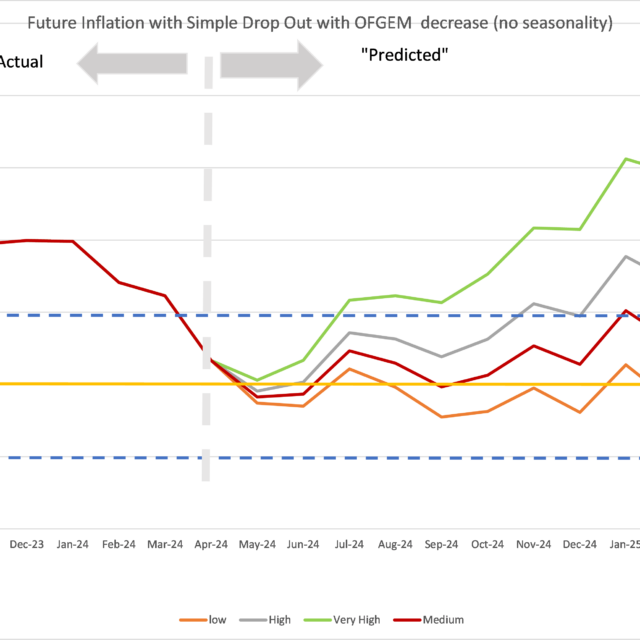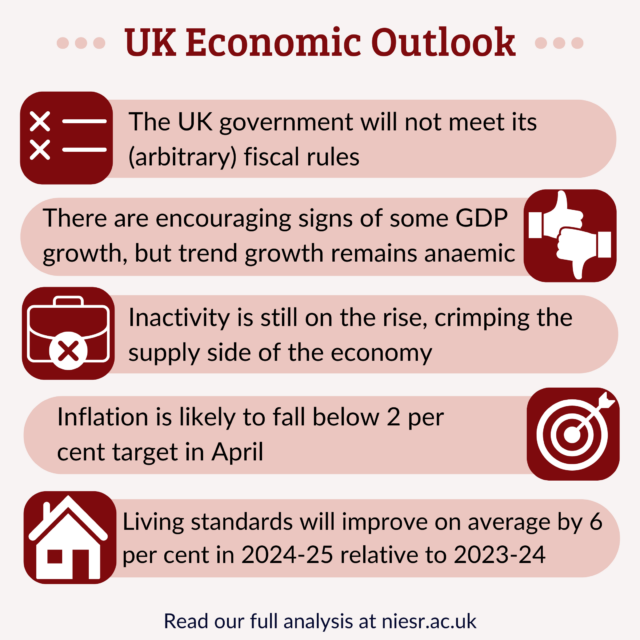Future Prospects for the UK Economy
Following last week’s publication of the NIESR Spring UK Economic Outlook and GDP Tracker, and looking towards this month’s Wage and CPI trackers, Economist Paula Bejarano Carbo sat down with Senior Communications Manager Luca Pieri to discuss the current state and future prospects for UK economic growth.

Given last Friday’s GDP figures, the UK economy seems to be on an upward trajectory… is that the case?
According to the most recent ONS figures, monthly GDP grew by 0.4 per cent in March, following an upwards revision of GDP growth of 0.2 per cent in February, driven by increased output in services sectors. Looking at the broader picture, GDP grew by 0.6 per cent in the first quarter of 2024 relative to the last quarter of 2023, in which GDP contracted by 0.2 per cent. This quarterly growth figure is the highest recorded since May 2022.
In our latest GDP tracker, my colleague Hailey noted that the strong GDP data for March and the first quarter of 2024 were encouraging, especially in the context of contracting GDP growth towards the end of 2023. Moreover, it is positive that higher-frequency data point to this momentum in economic growth continuing in the second quarter of this year. For example, Purchasing Manager’s Indices – which compile information from surveys posed to businesses to produce a measure of business activity – suggest that private output can be expected to expand further in April, following a year of subdued growth. As noted in our Spring UK Economic Outlook, we project this momentum to continue throughout the year, culminating in an annual GDP growth rate of 0.8 per cent in 2024.
What does this mean for the medium- and long-term growth prospects?
While the above is certainly a positive outlook for the short-term, given the extent to which growth was muted in 2023 driven by the compounding effects of the cost-of-living crisis and monetary tightening cycle, the outlook for the medium-term is less optimistic.
In our Spring Outlook, we note that we expect growth from 2025 onwards to fluctuate around a trend growth rate of 1 per cent – which is low both by historical and international comparison. This is consistent with the sluggish growth trend that we’ve observed since the Global Financial Crisis. To escape this low-growth trend, significant policy change will be required. As we consistently argue, such change ought to be include an overhaul of the fiscal framework, increasing public investment in such a way that can crowd-in private investment, and structural reforms that will raise the UK’s potential growth rate.
The latest Outlook found that the next government will likely have to raise taxes…. why is that the case, and how does that relate to the projection for low medium-term GDP growth that you mention?
The current UK government’s fiscal rules state that the debt-to-GDP ratio should be falling within a five-year horizon and the deficit-to-GDP ratio should be below 3 per cent by the end of the same period. On the assumption that the next government will stick by these fiscal rules (which is by no means necessary, nor desirable), I will explain why we think that the next government will likely have to raise taxes.
Firstly, we project that these fiscal rules will not be met. To explain: these fiscal targets are calculated as percentages of GDP, and thus, any forecasts of these variables will reflect both spending/tax plans as well as projected GDP growth. Of course, both elements of this calculation will reflect a broader forecast of the UK economy. For example, in the context of inflation being forecast to come back down to target, fiscal drag will be lower than in the recent past – reducing projected tax revenue. But, a decreasing rate of inflation is also likely to boost expected output. Given that our forecast for the UK macroeconomy is conditioned on current government spending and tax plans, but predicts a lower GDP profile than, e.g., the Office for Budget Responsibility’s forecast, our forecast altogether suggests that the government will miss both of the above fiscal targets. Specifically, we project that the deficit-to-GDP ratio will stand at 5.1 per and the debt-to-GDP ratio will rise to 101.8 per cent in the fiscal year 2028-29.
In the context of struggling public services, we do not believe it would be beneficial nor credible to make plans to cut spending. Thus, if economic growth proves to be as low as we project, we believe that any future government that chooses to maintain the fiscal rules will have to raise taxes. However, as I mentioned above, NIESR research argues that it is neither necessary nor desirable to do so. To elaborate: these fiscal rules are essentially arbitrary and incentivize short-term policy decisions over long-term ones, such as committing to maintaining a sustained increase in public investment that could boost long-run growth.
We therefore believe that a revised set of fiscal rules would better serve the United Kingdom by incorporating medium- to long-term economic objectives in a new fiscal framework. For example, the United Kingdom is legally obligated to reach net zero by 2050. This target will only be met if supported through well-judged public investment in green infrastructure. Such investments could be made exempt from measures within the existing targets, so that they are separated out from current day-to-day spending. However, this could possibly lead to political pressure being exerted on which spending plans benefit from arbitrary separation of the fiscal target calculation. Alternatively, a revised fiscal framework could incorporate public sector net worth as a target. This provides a broader measure of public debt sustainability inclusive of what the government owns and what it owes.
As noted in Chadha et al. (2021), there are many other ways in which the fiscal framework could benefit from revision – including establishing a fixed schedule for fiscal events. The bottom line is that these fiscal rules desperately need rethinking; otherwise, we may find ourselves in a higher-tax, low-growth, struggling public services environment.




















